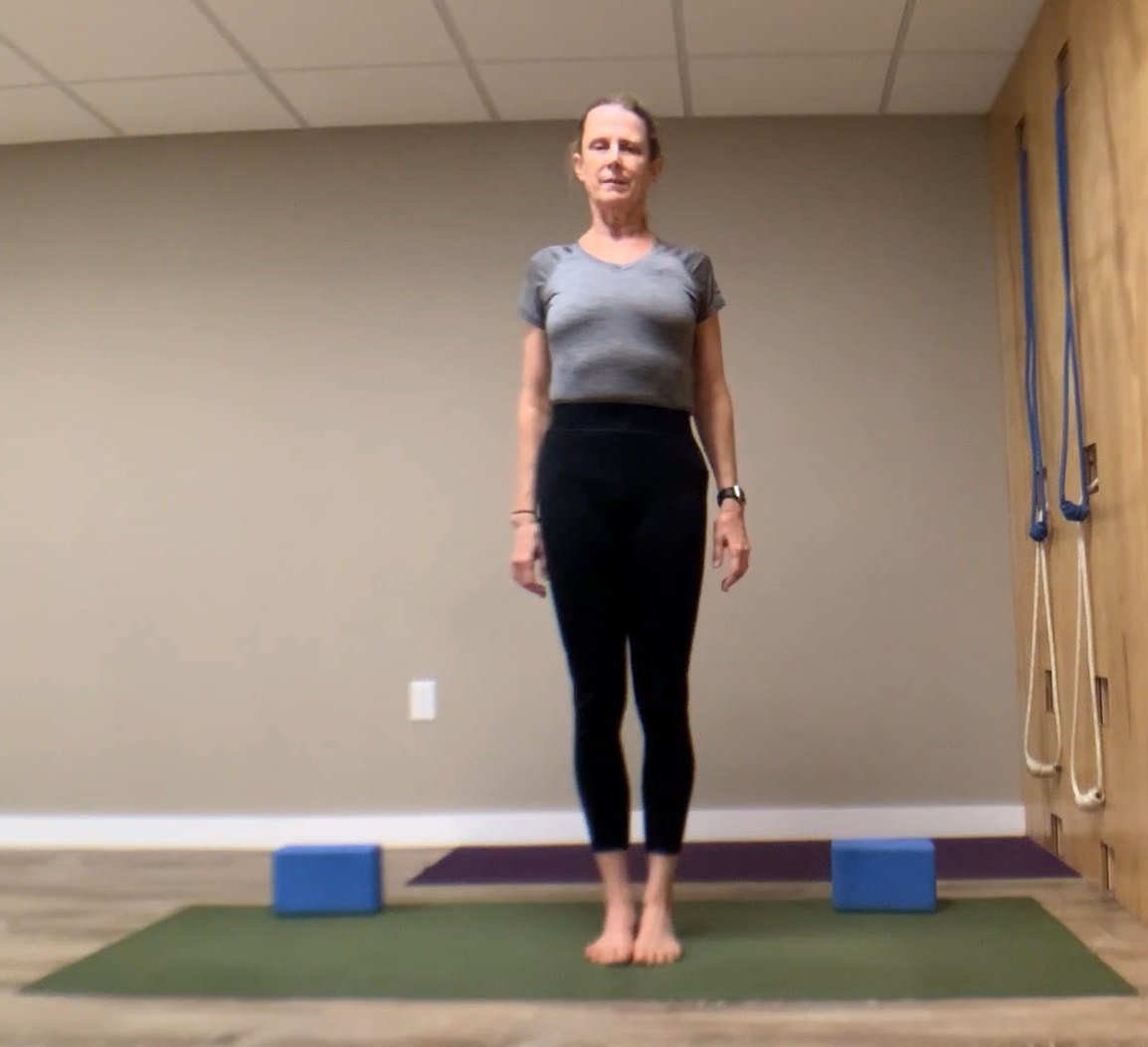LEARNING TO STAND
The first part of this chapter is about learning to stand in a balanced way. You may think you know how to stand, but unless we are paying attention, we all stand in somewhat unbalanced and crooked ways. To quote Mr. Iyengar: “A defective posture creates an imbalance in the legs and spinal muscles, eventually inviting ailments.”
The word Sama means even or balanced. Samasthiti is an asana in which both sides of the body, left and right, remain identical. This pose is also known as Tadasana which means to stand upright and firm like a mountain.
Samasthiti is the pose upon which all other poses are based.
Technique from the book:
· Stand with the feet together. Join the big toes, ankles and heels.
· Do not clench the toes, extend them from the mounds to the tips and spread them wide.
· Distribute the weight evenly between the heels and the toes, between the inner edge of the foot and the outer edge, and between the right and left foot.
· Grip the knee caps and lift them upwards. The knee joint must hold the thigh and the sin together as one
· Contract the buttocks and lift the quadriceps up towards the pelvis.
· Roll the front of the thighs from the outside to the inside, and the back of the thighs from the inside out.
· Lift the lower abdomen vertically up; do not let the belly protrude.
· Tuck the shoulder blades into the body, keeping their inner edges parallel.
· Roll the shoulders back and expand the chest. Lift the front of the chest as well as the sides of the ribcage.
· Keep the spine erect, the neck relaxed and the head straight. Look straight ahead. If the eyes wander, they create an imbalance that causes the body weight to shift from one foot to the other.
· Breathe normally
These instructions are common to many poses. You can use the instructions for the torso in any pose where the torso is straight: Virabhadrasana I, Adho Mukha Svanasana, Adho Mukha Vrksasana, Vrksasana, Virabhadrasana II, … You can use the leg instructions for any pose where the legs are straight: Uttanasana, Trikonasana, Prasarita Padottanasana, Sirsasana…
In Tadasana, or Samasthiti, the feet are held together if possible. There are many reasons to have the feet hip width apart: balance, bunions, back pain.
BKS Iyengar says that those with ailments of the spine: lower back ache, disc problems or prolapsed uterus should stand with the big toes touching and the heels turned outward, in other words, pigeon-toed. He says to “suck the kneecaps in”. This helps to stretch and straighten the backs of the legs. It also makes the legs firm so that the body weight is distributed evenly on them: Samasthiti, or even standing.
This method of standing with the toes in and the heels out allows the spinal muscles to spread sideways and to ascend, relieving back pain.
LEARNING TO RAISE THE ARMS OVERHEAD WITHOUT DISTURBING THE REST OF THE BODY.
In Samasthiti, the various arm variations are learned. This is so that the practitioner can learn to move the arms without affecting the rest of the body.
Some of these arm positions are:
Urdhva Hastasana = Urdhva means upward, hasta means hands. The arms are raised overhead with the palms either facing each other or facing forward.
Urdhva Baddhangulyasana: Urdhva means upward, Baddha is bound, anguly are the fingers: arms raised overhead with the fingers interlaced. Make sure you change the interlace of the fingers when you practice.
Samasthiti teaches the art of balancing the body weight evenly on both feet. A defective posture creates an imbalance in the legs and spinal muscles, eventually inviting ailments.
Samasthiti and its variations help to correct the defects of incorrect posture The chest expands, freeing the breath. The buttock muscles contract, while the knee and elbow joints become firm and straight. We often stand carelessly with the feet turned out, which turns the lumbar muscles inward and causes pain in the waist. In correct standing position, the frontal thighs are rolled inward and the hamstrings outward, which relaxes the lower back muscles. With this awareness, the gait improves, the body becomes supple and the mind gets revitalized.
Actions like raising the arms and interlocking the fingers look simplistic; but they are important for the beginner as each action has a different effect:
· Raising the arms with the palms apart works on the upper arms, while the entwined finger action eliminates stiffness in the elbows and finger joints and the small muscles of the hand.
LEARNING TO DEAL WITH THE DISCOMFORT OF CHANGING YOUR PATTERNS AND HABITS.
Mr. Iyengar says that when we begin to work with hitherto unused muscles and joints we will experience a fair amount of pain. One must always use discrimination between right pain and wrong pain.
“Right pain is not only constructive but also exhilarating and involves challenge. Wrong pain is destructive and causes excruciating suffering.”
- BKS Iyengar, Light on Life
Even in the simplest of poses, done correctly, we may become sore. This is because our muscles and joints are habituated to incorrect positions and become rigid in the same position due to lack of use. The pain of stretching is a positive sign. It indicates that the limbs are being forced out of their stupor and made to work.
“If the body is allowed to stay in a comfortable position for too long, it falls prey to future aches, pains and ailments. To avoid the pain of disease and disorder in later life, it is essential to endure the pain of asanas before maladies strike. The path to good health flows through the pain of asana practice.”
Bringing awareness to the simplest of actions, even an action as basic as standing upright – is a step closer to enlightenment.



